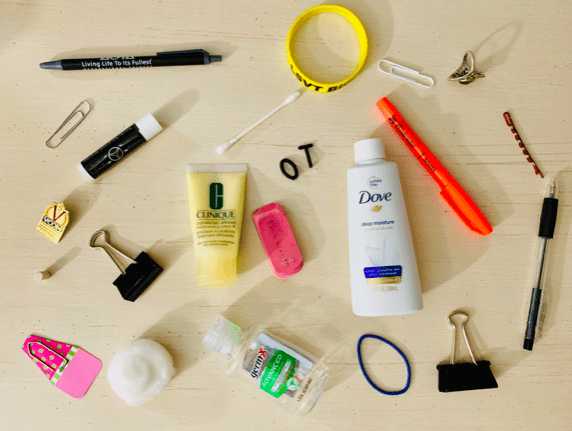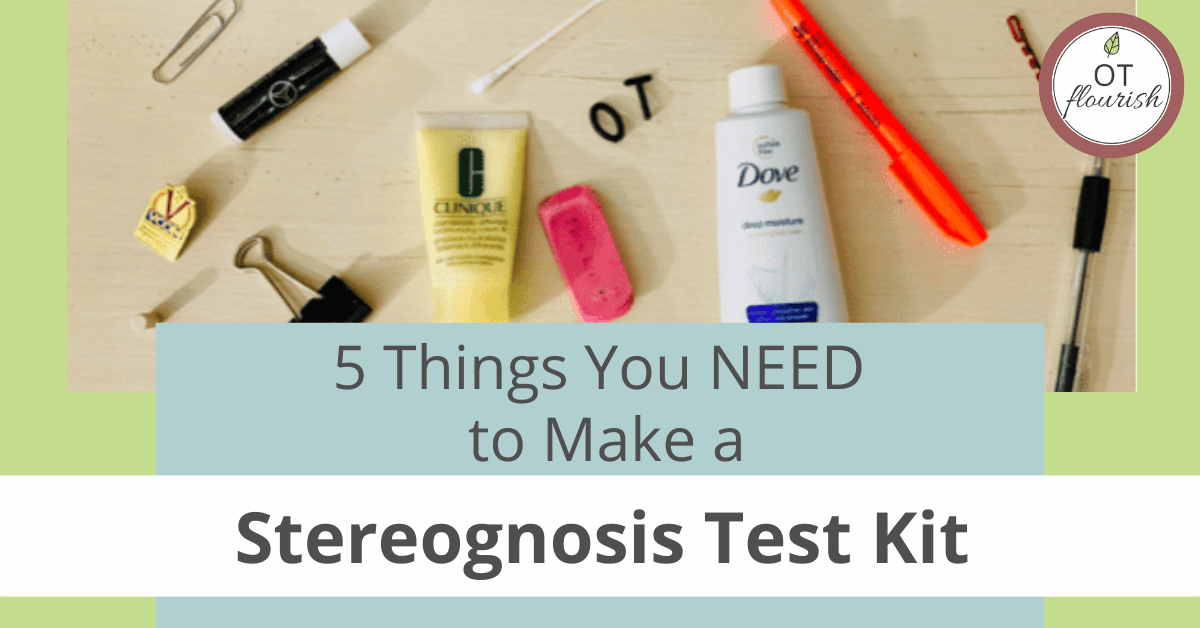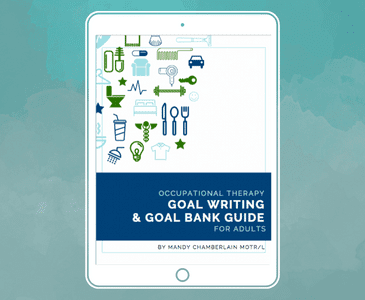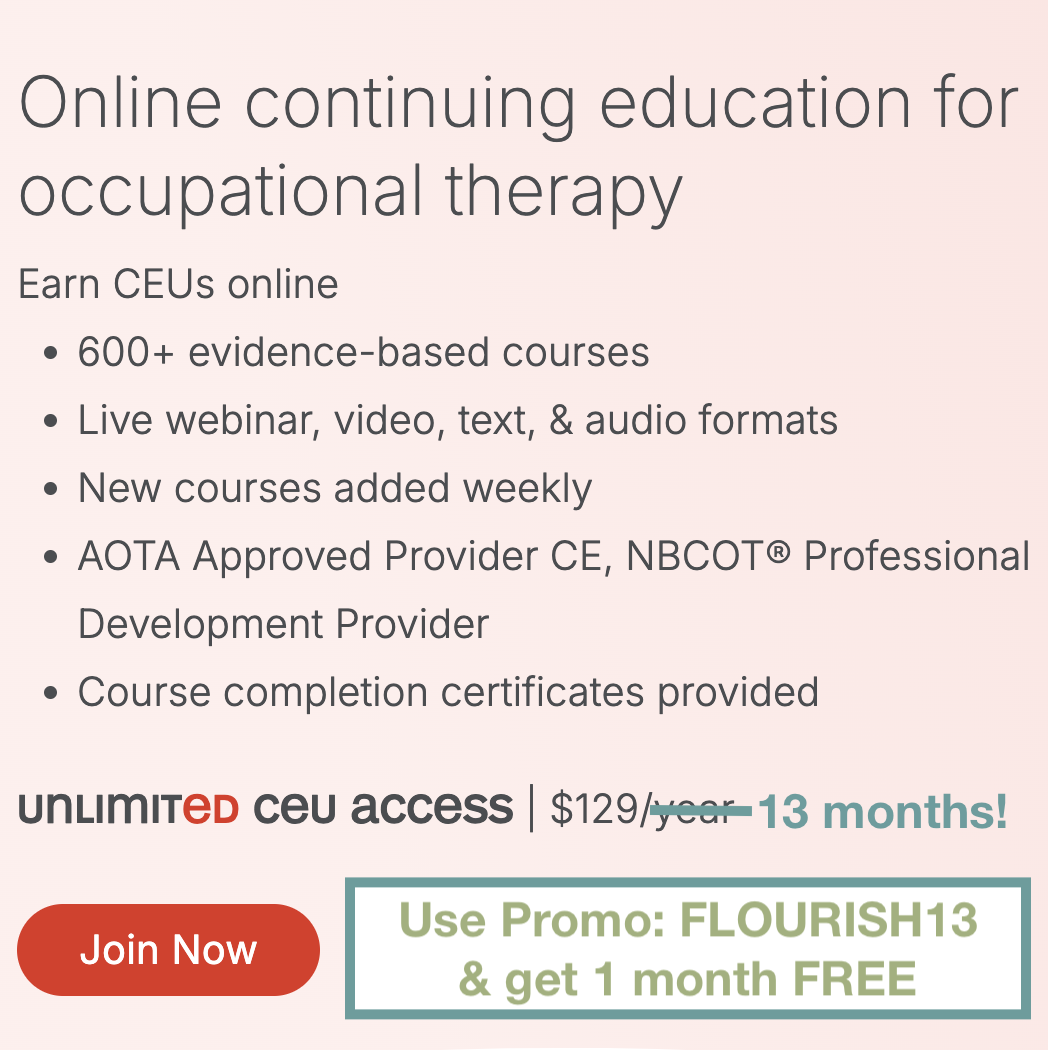We are digging into the who, what, when, where and why of stereognosis in occupational therapy and how to create a kit for your clinic.
- It is for the person WHO has ever experienced not being able to find their alarm clock on their bedside table in the dark of the morning.
- It is WHAT is attempting to occur when you try to feel around to shut off the alarm without turning on the light to see.
- It ponders the scenario – Imagine you are driving in your car, WHEN you stick your hand into your glovebox, use your touch perception and successfully find your sunglasses without taking your eyes off the road. This is also referred to as a community mobility safety win!
- It is the WHERE and WHY does your ability to discriminate between objects without looking even matter?
In Part 1 of this 2-part article series we will get into the “who”, “what”, “when”, “where”, and “why” about stereognosis and what it has to do with occupational therapy and adults. Part 2 will go over the “how” to incorporate tests into your OT screenings and evaluation. Then in Part 3 of the series, we will dive into “how” to down grade and up grade treatment and activities!

WHAT is Stereognosis?
- It is a higher cerebral associative cortical function
- In involves using your touch perception and tactile discrimination skills to recognize an item or group of items hidden from your view
- It is the ability to identify items using tactile information
- It is a function of the parietal lobe, where sensory information is processed
- Is common to occur after a neurological event such as a stroke requiring intervention (but this is not exclusive)
WHO can be affected?
People who have had recent sensory changes may have new difficulties in all of those above-mentioned scenarios. Know that stereognosis deficits can present in people throughout the lifespan; for this article, however, we will focus on adults.
- Your grandmother who has macular degeneration who has stopped putting on her favorite pink “rouge” because she can no longer see the label and has trouble feeling for the lipstick tube in her full drawer of makeup…
- A great uncle who is recovering from residual changes from a TIA of a few months ago who has greater difficulty managing to tie his bowtie due to inability to feel for the loophole…
- The secretary of your OT program who resorts to her dumping out the contents of her lap desk bag out onto a table because she takes longer to feel around for her favorite pen…
WHEN does occupational therapy have a role?
Occupational therapy practitioners have a role in stereognosis testing and intervention implementation when there is a change. Occupational therapists should create the habit to incorporate this testing into our sensory assessment portion on an individualized patient to patient basis.
We should listen to what our patient or their family members report and if warranted upon assessment results, then interventions that target these deficits are appropriate to be incorporated in addressing multiple purpose skills with the hopes of improvement for overall performance areas such as in the areas of improved ADL or IADL independence.
WHERE do we get supplies for assessment and activities?
Gather supplies for assessment and intervention therapeutic activities by shopping around in your clinic, in the hospital, or in your home without spending any money. Supplies can also be purchased at your local dollar store, tool store, or pharmacy. It might also be helpful to create this kit as a part of an array of different occupation based kits for your facility.


Common object examples to include in your testing kit include:
- Cotton balls,
- Coins,
- Domino pieces,
- Large or small eraser,
- Pen/pencil,
- Paper clip,
- Binder clips,
- Buttons,
- Rubber bands,
- Puzzle alphabet shapes,
- Small bottles,
- Screws,
- Plastic utensils,
- Marbles,
- Dice,
- An old ring,
- A rubber bracelet,
- Keys,
- Mini toothpastes,
- Toothbrushes,
- Hair comb,
- Dried beans,
- Small relative items of your patient


What items you choose does not matter as much as it matters to make sure that your items will not cause harm to your patient
Example: If your patient is very impulsive with poor safety awareness use extreme clinical judgment to determine level of appropriateness (here is an article on how to work on safety using a scavenger hunt activity).
Questions to ask self:
- Will my patient try to put an object in his/her mouth to swallow?
- Is my patient at risk for cutting self if he/she feels for the plastic spoon or clips?
- Am I abiding all policies for cleanliness such as wiping down objects with purple tops between patients or replacing objects after one use such as in the case of Qtips or cotton balls?
WHY is Stereognosis Important in OT?
- Scenario Rationale: When you unbutton your pants do you realize that you are feeling for the button and differentiating it from the buttonhole? Or after you complete going to the restroom and hurriedly zip your pants, do you notice that you feel for the zipper tie to pull up the zipper? Do you notice how quickly you can feel, zip, and pull? What if that skill was taken away from you? Think about how that personal occupation (activity that is meaningful or necessary to do for life) of toileting and dressing could drastically change.
That is exactly why OT plays a role in this assessment, interventions and outcomes.
- Short answer: Maximize Task Automatics During Occupations
- Long answer: Deficits can prevent a patient from easily and “automatically” complete personal tasks related to components of Activities of Daily Living (ADLs) such as dressing; therefore, we as occupational therapy practitioners should try to assess and address this skill in our practice. Additionally, other components that can be combined into these activities include memory, sequencing and cognitive item categorization, among others. Occupational therapy can also address the speed and “automacy” of the task to promote improved engagement and performance in multiple different occupations.
Stay tuned for Part 2 (and Part 3!). This will provide the nitty gritty “how to” assess and screen for possible deficits, as well as provide the “how to” grade down and grade up therapeutic activities as tailored interventions.
About our guest blogger

Shannen Marie Coley, MS, OTR/L is an occupational therapist that is passionate about adult inpatient rehabilitation, patient wellness, professional development, advocacy, and occupational balance. She is an LSVT BIG certified clinician since 2018. Since graduating OT school in December 2016, Shannen has worked in the hospital and inpatient rehab settings serving adult patients of variable backgrounds, stories, and upbringings with a variety of neurological, cardiopulmonary, orthopedic diagnoses. Shannen enjoys writing and sharing tidbits of OT related stories on her blog ShannenMarieOT.com and is active on Instagram (IG) @shannenmarie_ot. Shannen is married to her college sweetheart and they have one child – a six toed cat named Gravy.





